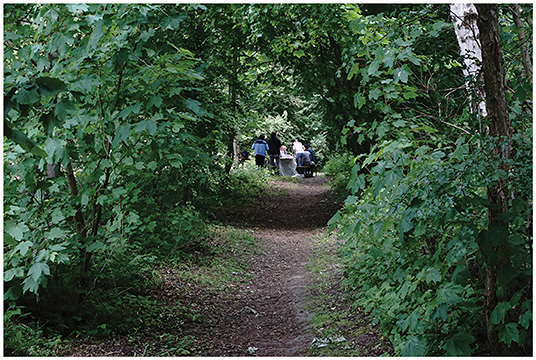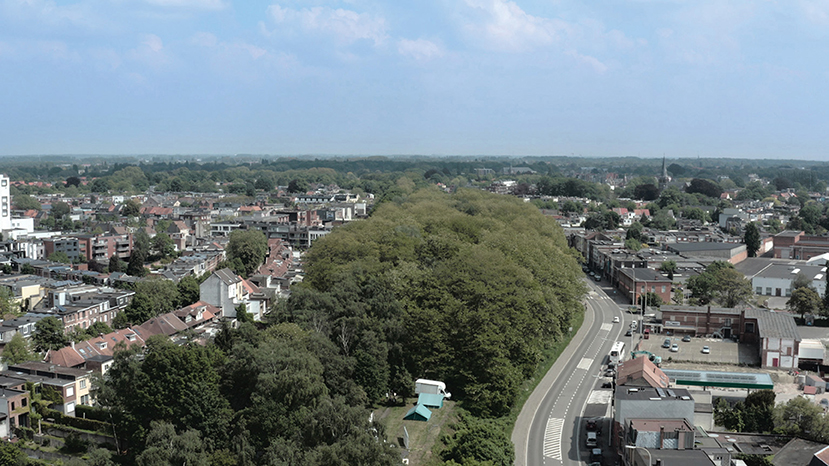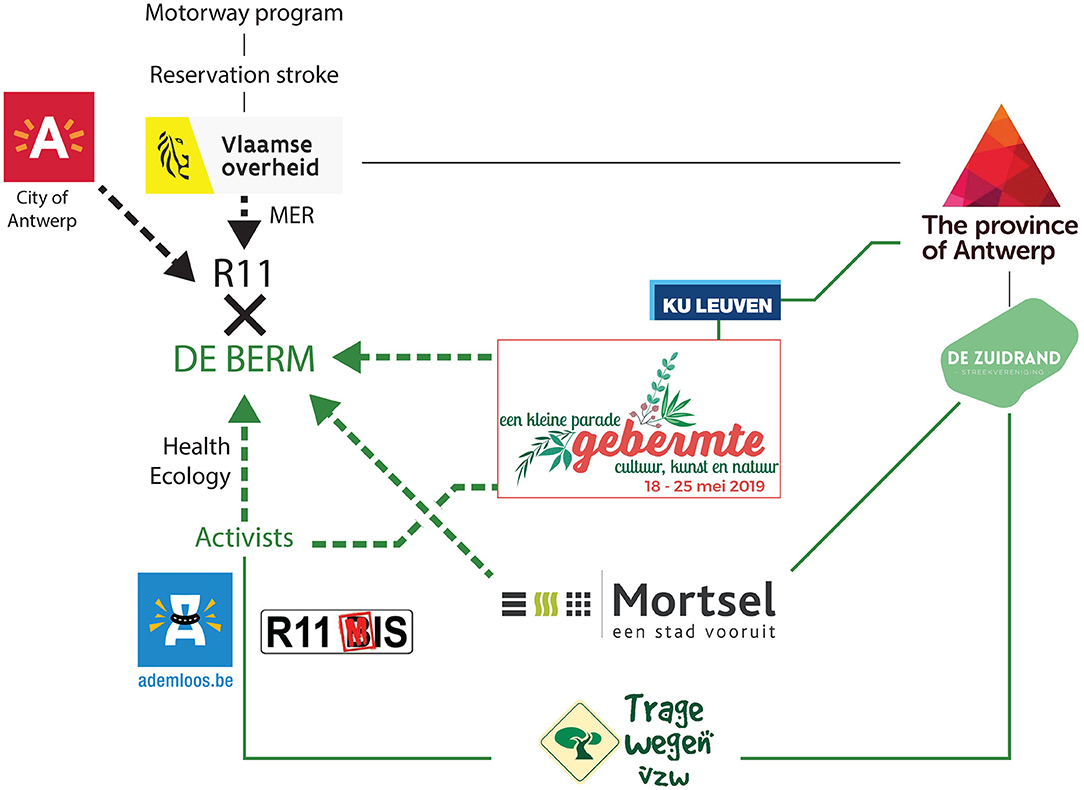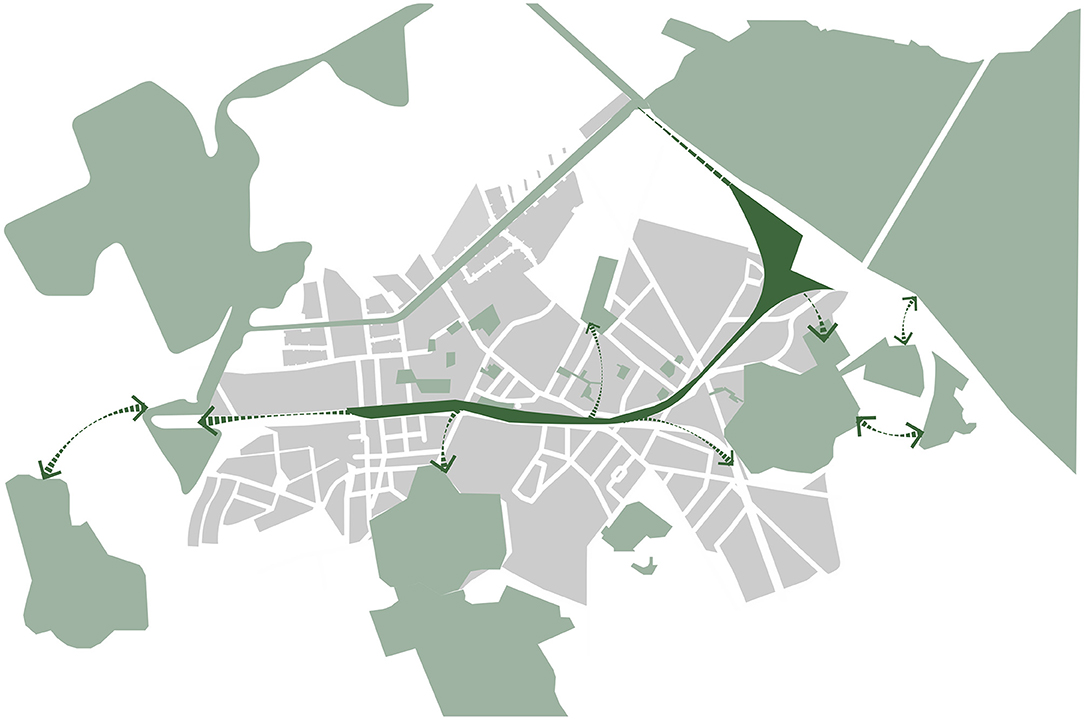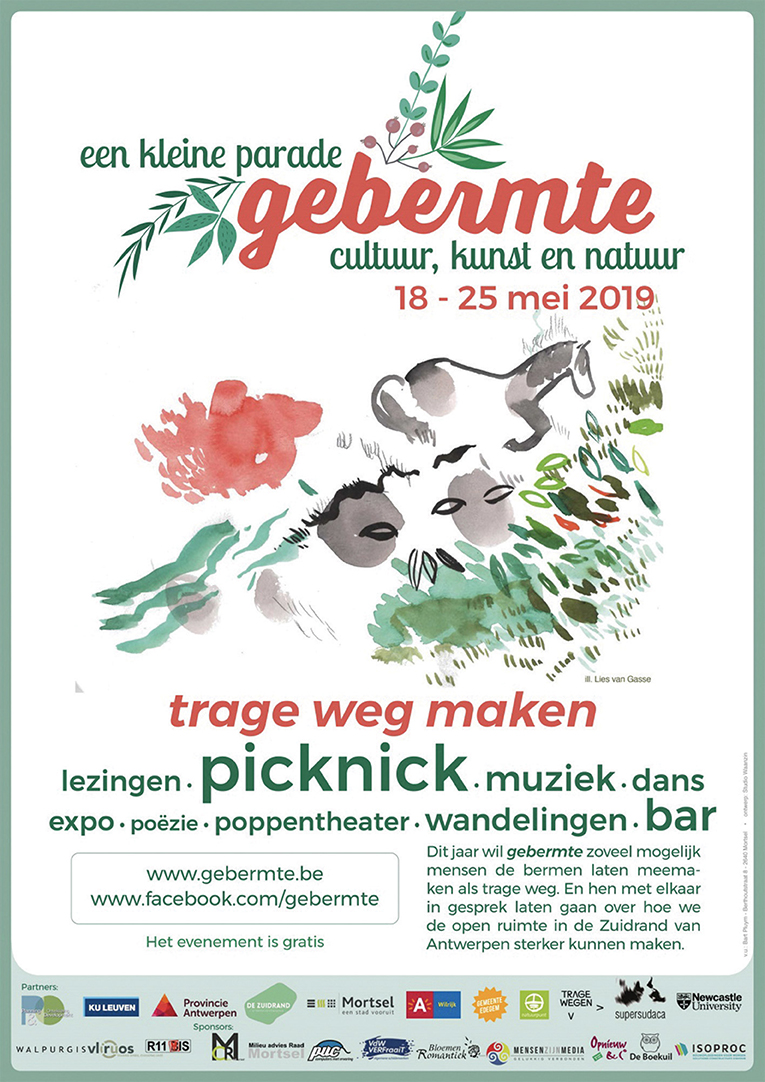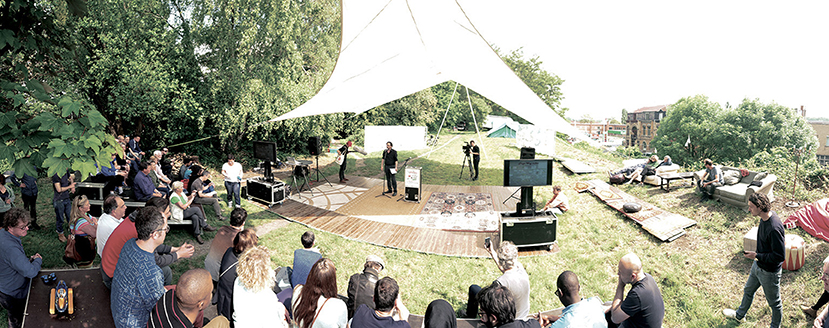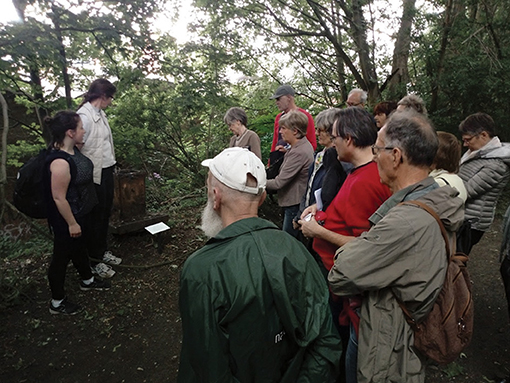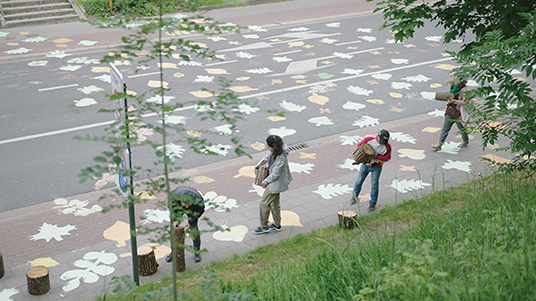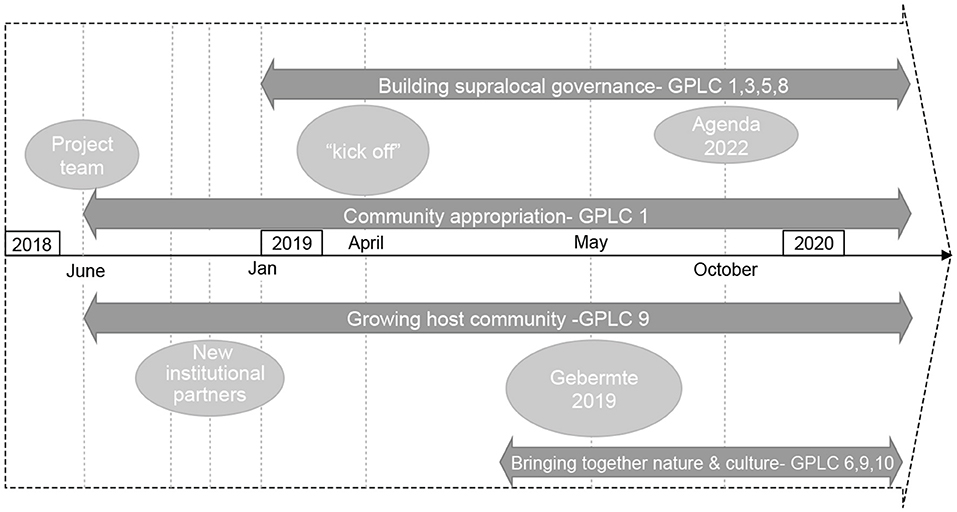- 1Research Unit Planning and Development, Department Architecture, Faculty of Engineering Science, KU Leuven, Leuven, Belgium
- 2Advanced Master of Urbanism, Landscape and Planning (MAUSP), Department Architecture, Faculty of Engineering Science, KU Leuven, Leuven, Belgium
- 3Research Unit Planning and Development, Faculty of Engineering Science, Department Architecture, KU Leuven, Leuven, Belgium
This paper explores the transformative potential of Commoning for establishing an urban governance arrangement of an inter-municipal slow path connection located on a former railway embankment—the “Berm” in Mortsel, in the Province of Antwerp, Belgium. To do so, this paper makes use of French pragmatist sociology, namely the “Théorie des Cités (TdC)”, and proposes what we term a “TdC plus” (TdC+), which enhances the TdC with insights from personal psychology, interpersonal interactions and socio-institutional dynamics; the TdC+ also incorporates features of the Landed Commons (Grand Principles of the Landed Commons) into the TdC's approach of common good and operationalises it from an Action research perspective. The paper focuses on the transformative potential of “Gebermte 2019”, an arts-based local initiative aiming to support the establishment of a slow path on the Berm. It illustrates how small scale actions, such as citizens' cultural activities (considered as embedded in processes involving multiple actors over an extended period of time), can be instrumental in empowering civil society groups and help overcome conflict and foster collaboration. It explores the role of supralocal urban governance arrangements in making local initiatives more effective.
Introduction
Since the 1960s, Belgian/Flemish cities have been drastically affected by suburbanisation (Kesteloot, 1990, 1993; Albrechts, 2001; De Decker, 2004, 2011; Braem and Strauven, 2010; Pauwels, 2014). They have witnessed ecologically unsustainable land consumption resulting from the privatization and marketization of property, the redefinition of land use rights, speculative practices, large-scale car oriented infrastructure development and industrialization of agriculture—all of which have, amongst other things, caused the petrification of the natural landscape and an increase in traffic jams and spatial fragmentation (Morozov, 2013; Van den Broeck et al., 2014; Van den Broeck and Verachtert, 2015; Morozov and Bria, 2018).
Landed Commons and community-based hybrid governance systems propose an alternative to (and represent a reaction toward) ongoing market driven land consumption systems (Swyngedouw and Jessop, 2006; De Rynck et al., 2017; Manganelli and Moulaert, 2018; Manganelli et al., 2020). These systems seek to reappropriate space for multiple users in ways that ontologically supersede the predominant market logics (Hardt and Negri, 2009; Harvey, 2012; Bollier and Helfrich, 2014; Dellenbaugh et al., 2015; Stavrides, 2016). This paper takes the slow path on the Berm as a case study to provide insight into how LCs and their multi-partner hybrid governance can overrule the predominant market perspective on the governance of land access and use rights.
LCs have been investigated by many scholars as ways to create an ecologically sustainable and socially just way of managing land from a diversity of perspectives (see e.g. Van den Broeck et al., forthcoming). These include: (1) an economic approach (e.g. the neoclassical thesis, Hardin, 1968), (2) historical analysis (e.g. De Moor, 2012), (3) an institutionalist perspective (e.g. Polanyi, 2001), (4) a Marxist approach (e.g. Harvey, 2012; Mattei, 2013; Dardot and Laval, 2014; De Angelis, 2017), and (5) seeing Commons as a pool of resources addressing self-governance structures (e.g. Ostrom, 1990). Many authors such as Linebaugh (2009), Helfrich (2012), Meretz (2014), Euler (2018), and others see the Commons as a continuous process requiring participation; scholars have described the production and reproduction of Commons (Harvey, 2012; Iaione, 2012; Kip, 2015; Stavrides, 2016; Ganugi, 2018) and the governance arrangements that the actors set up for its management (i.e. Commoning institutions; Harvey, 2013; Dellenbaugh et al., 2015; Stavrides, 2016).
Nonetheless, in contrast to Social Innovation literature (Moulaert and MacCallum, 2019), few authors have studied the process of building a Commons as a multi-actor process analyzing the actors' motivations and inspirations in engaging in a Commoning process, their modes of communication and interaction and the ways in which they engage in coproduction. To address this gap, this paper makes use of French pragmatist sociology, namely the Théorie des Cités (TdC) (Boltanski and Thévenot, 1991), and enhances it with insights on: politico-institutional dynamics in which Communities of Practice (CoPs) operate; social relations between person-actors; personal and interpersonal psychology of person-actors; and the dynamics of the co-creation of a “monde commun”. The “TdC+” is thus an analytical tool for transdisciplinary research used to clarify and support the construction of a Landed Commons (LC) operationalised for Action research. The paper makes use of the so-called Grand Principles of Landed Commons (GPLC) expressing features of how a Landed Commons and its governance should be designed and co-constructed or how its genesis can be evaluated (cf Chapter 2.1 and 2.2 in Van den Broeck et al., forthcoming). The research shows how the GPLC can guide co-construction by exploring social, political and institutional dynamics of the governance of the Commons. Furthermore, the research demonstrates that a TdC+ Action research process is “just as much a Commons as the ‘Commons under construction' itself” (Moulaert et al., 2013).
Following this introduction, the paper provides an analysis of the methodology (including the “TDC+” theoretical framework), an introduction to the case study, and a summary of research methods (section The Théorie des Cités Plus and its Methodological Framework). The following section (Retrospective Analysis of Interaction Moments During Gebermte 2019) provides a narrative of the case study Gebermte built up in TdC+ terms. Section Retrospective Reflection of the Gebermte 2019 Co-Construction Process, Structured Along Principal Dynamics and Assessed With the Gplc covers a retrospective reflection on the co-construction process, structured along four principal dynamics and assessed according to the GPLC. Section Conclusion explains how processes of Commoning can be interpreted as multi-layered processes in which actors—through their interpersonal interactions and their belonging to multi-scalar CoPs and networks—build collectively defined, co-produced, negotiated and governed shared resources: in brief, Commons.
The Théorie Des Cités Plus and its Methodological Framework
Theoretical Framework
The Théorie des Cités (TdC) (Boltanski and Thévenot, 1991) explicitly focuses on the justification, negotiation and co-creation processes between person-actors and sheds light on why they collaborate to co-create a new world or, from our perspective, a (new) Commons. By teasing out the relative influence of structure over agency and by focusing on situations and interaction moments from which concrete shared objects emerge from processes of justification, Boltanski and Thevenot formulate a more fine-grained understanding of negotiations, in which person-actors refer to cités [referential worlds] of Common good (Cfr. Chap 2.1/2.2 in Van den Broeck et al., forthcoming).
In the TdC, cités are referential categories of the “Common good” that, depending on the actors' affinities, impede or facilitate consensus. Cités are politico-philosophical constructs to which actors in a specific situation of negotiation consciously refer to or unconsciously position themselves accordingly toward. Each of these cités is structured around a limited number of grandeurs, understood to be a set of reference values or main principles. The cités are logical constructs conveying a socio-political vision of how a “just” society should be organized and of the values determining the worth of persons in a society. The TdC puts forward a universal tool for justification, in which different persons enact discussions intent on evaluating the “worth” of the other participants within their world (referring to cité and its object). Thus a cité does not only refer to its grandeur, but also to its world in which its êtres are organized according to the grandeur. A civic world is based on the representation of a collectivity. In the market world, competition and wealth are the structuring and justifying elements; while from the industrial perspective, efficiency and scientific rigor are the sources of grandeur (see Table 1).

Table 1. Cités: their values and grandeurs, valorised and devalorised characteristics determining their worth.
The TdC is a powerful interpretative tool that helps to disentangle the complexity of positioning by person-actors and institutional referencing in a justification, negotiation or co-construction process. But for several reasons, it is not straightforwardly applicable in empirical Action research.
The main reason is that the theory “lacks action research experience”. Although partly based on detailed interviews with contemporary actors (especially the “cité par projets”, Boltanski and Chiapello, 1999, the TdC has rarely been applied as a guide to an Action research trajectory. This lack of groundedness is revealed by its limited interest in the social roles of actors, in the psychology of interpersonal relationships and personal attitudes and in the politico-institutional complexity in which the actors operate.
To move beyond TdC's weaknesses, the paper mobilizes an enhanced TdC, a “TdC+”, operationalised for Action research and developed in chapter 2.1 and 2.2 of the INDIGO Book (see extensive elaboration in chapter 2.1 and 2.2 Van den Broeck et al., forthcoming). Apart from socio-political and institutional processes, TdC+ takes into account the referential logics and personal, interpersonal and social psychology of person-actors fostering the building of community-based land use developments and governance arrangements referred to as the Concrete Landed Commons (CLC).
With TdC+, Van den Broeck et al. (forthcoming) turn to the dialectical dynamics of actors and institutions in reaction to the exaggerated de-structuralization of the analysis of personal interaction in the TdC. Even if Boltanski and Thévenot (1991) criticize Bourdieu and others for overemphasizing structural mechanisms, they themselves tend to make actor-centered statements that obscure actors' institutional embeddedness. TdC helps to understand the making of old and new institutions but, except for Cités as signifiers of particular institutional logics, it does not contribute to explain how socio-institutional logics affect the position of person-actors in real-life situations (for example, as representing a Community of Practice, as being in an employment relationship, and so on). TdC+ then offers a model that allows reconstructing the time and space dynamics of the actor network, the actor geography, the factors driving person-actors and actions, as well as interactions at sequential points and situations in time. The model can be applied retrospectively, requiring an analysis of earlier interaction dynamics as well as prospectively/co-constructively focusing on shared visioning, negotiation, analysis and co-construction.
In the retrospective analysis, the (Grand) Principles of the Landed Commons (GPLC) can be used to evaluate the Commons' features of an achieved or pursued concrete product (Concrete Landed Commons, CLC). This mirroring of how and in what sense a CLC has been built equally allows for identifying future directions for the CLC: the try-out of the Grand Principles as a kind of utopian search. In the prospective/co-construction approach, the Principles of the Landed Commons serve as a guide to the co-construction process (reference to leadership, mediation, conflict resolution, facilitation roles, etc.—criteria for co-defining the Landed Commons and its governance, in comparison with other cases). They can also be used to read and interpret other inspiring experiences of building Landed Commons.
In Action research making use of the TdC+, a case is approached as an evolving partnership of person-actors, many of whom are protagonists of a Community of Practice (CoP). The construction of a CLC includes the gradual materialization of its geographical boundaries and governance features through a sequence of interaction and co-construction moments (see Figure 1).
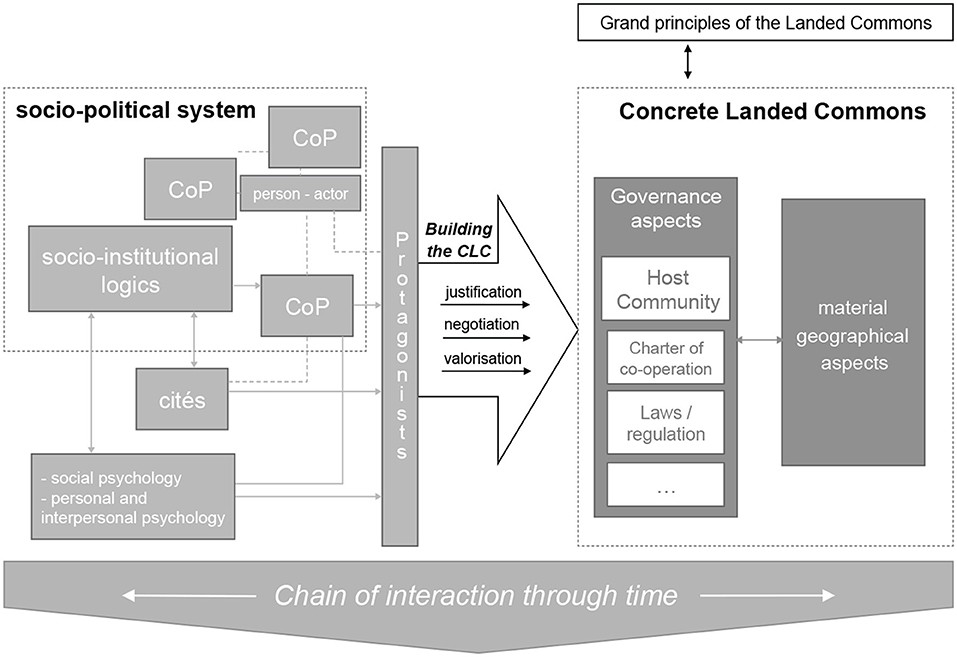
Figure 1. Eclectic representation of the making of the Concrete Landed Commons. Source: Chapter 2.1 in Van den Broeck et al. (forthcoming).
Introducing the Case Study: The Berm and the “Gebermte” Initiative
The TDC+ was explored in the case study of the “Gebermte 2019” initiative on the “Berm” in Mortsel (See Figures 2–4). The Berm is a former railway embankment crossing the city of Mortsel and the district of Wilrijk south of the city of Antwerp (the “Antwerp Southside”). It has been subject to different large-scale infrastructure plans and proposals, as a potential location for upgrading for the adjacent interregional road R11. These plans have been contested by local residents, who have organized themselves to challenge the intended use of the Berm.
In 20111 and 20142, a plan of the R11 Bis3 that aimed to relieve vehicular traffic on the ring of Antwerp and trespass the current footprint of the Berm triggered local community-based resistance. In 2016, the re-surfacing threat to the Berm's existence as a green public space spurred a community-based reaction. This response went beyond a claim for the preservation and legitimation of the Berm and led to a more constructive and locally rooted form of contestation, which prioritized the re-Commoning of the Berm—not by public authorities or private interests, but by residents united in the Gebermte initiative.
Gebermte is a participatory artistic experiment that involves residents and visitors of Mortsel, Wilrijk, Edegem and the surrounding area in the revaluation of the old railway verges. Since 2017, for three consecutive years, yearly events have been organized through Gebermte to claim the Berm as a cultural meeting place. By way of cultural performances, Gebermte aims at returning the Berm to collective use by the local residents and community. The 2019 event entitled “Making a slow path” included an academic component involving students and action researchers. Their Action research and 1 to 1 scale interventions widened the vision of the participants in the event to include the Berm's ecological role as an intermunicipal slow path. Connecting the Berm and its governance to the existing subregional policy and involving public authorities brought new institutional partners on board. In this way, Gebermte illustrates how intermediary spaces can offer connecting levers for Commons-based governance, thus revitalizing community input in diverse land governance arrangements.
Translating TdC+ Into Features of Interaction
As explained by Moulaert et al. in Van den Broeck et al. (forthcoming), in the time and space dynamics of the interaction/co-production process of LCs, each (interaction) moment is specific and must be narrated (and partly visualized) in detail, using TdC+ terms. For the operalisation of TdC+ we look at the following features of interaction:
- The discursive and material practices according to socio-institutional logics: for each moment of interaction, the type and features of interaction should be identified within their socio-institutional context. This includes, for example, politico-institutional logics in which person-actors interact and in which (C)LCs are built; socio-political regimes (and equally discourses) at different spatial scales and their articulation; the socio-institutional and politico-institutional logic of the CoPs; the socio-political “map” in which the person-actors “move around”; existing laws and regulatory systems and the manner in which they offer opportunities for creating and regulating a CLC; the state of the (supra) local governance system and how it evolves/should evolve (to facilitate the creation and governance of the CLC).
- The role of cités and values in discursive and material practices: this involves identifying how persons objectivise their values and grandeurs, valorised and devalorised characteristics (determining a cité's worth values or grandeurs belonging to archetypical cités), by justifying them in particular situations.
- The influence of socio-psychological positioning of protagonists and of other person-actors: in other words, the predisposition of persons in becoming aware of cités and their central values as triggers of behavior.
- The personal psychology of person-actors: to understand personal psychology of person-actors, we look at their behavior connected to their emotions (anxiety, pain, anger, hope, pleasure, etc.) and beliefs. These emotions have conscious as well as possible unconscious aspects. The unconscious is a mental activity that people are often not aware of; this can be understood as the mental territory to which dangerous and/or painful ideas may be consigned through repression or other defensive mechanisms, as well as a source of resistance to or flourishing of certain ideas and emotions (Vince, 2008). Understanding personal emotions (whether this involves being reintroduced to early experiences, developing “self-awareness” or acquiring “emotional intelligence”) can provoke positive change (Erfan, 2013). In line with Mindell (1995), we call for paying attention to and welcoming the expressions of emotional and symbolic dynamics, feelings and body symptoms, subtle movements and the dreams of everyone concerned. We suggest that working with unconscious desires, pleasure, wishes and positive ideas might even induce resilience and facilitate negotiations.
- Interpersonal psychological dynamics. Interpersonal psychodynamics refer to the interplay of emotional relations between person-actors. Insights from psychodynamics also show how action learning can be a parallel process in which the set dynamics play out as a microcosm of the wider organization or system. They can enrich TdC's interactive dynamics by focusing on the interplay of emotional dimensions with political and social relations, whereby they mirror the range of inequalities, tensions and emotional fractures that characterize groups, organizations and societies (Coghlan and Brydon-Miller, 2014). One reason for studying interpersonal interactions from a systems psychodynamic perspective is “to uncover the complexity of relations that are mobilized by human emotions, to show how publicly- displayed emotions reflect power relations and how the interplay between emotion and power creates surprising, self-limiting, unexpected, liberating, uncomfortable, interesting and unwanted structures for action” (Vince, 2008). Genuine sociality is an example of positive interpersonal relationships that are the key to human survival and wellbeing.
- Mindell (1995) also saw personal healing and collective healing—means of individual and collective change—as tightly linked. Similarly, Erfan (2013) sees therapeutic planning as a way of working through interpersonal and intergroup differences (i.e. conflict) and sees it as working through internal differences and personal dilemmas (i.e. trauma).
It is the task of researchers and process animators to disentangle the reference to cités from the socio-institutional logics of the Communities of Practice and the (socio-)psychology of the interpersonal interaction. With GPLC as criteria for progressive formation of the CLC, a time dynamic mapping of the person-actors, their positions, emotions and interactions that have been (retrospectively), and will be (prospectively), crucial for the development of the Landed Commons should be realized. This mapping will indicate why person-actors have interacted with their context (institutional logics), predispositions and psychology and cité affiliation.
This paper makes prospective use of the TdC+ through text analysis, more than 30 semi-structured interviews, informal conversations, as well as participatory observation during meetings, events and a range of participatory activities. Throughout the course of the research, the TdC+ was applied to define the evolving partnerships. Researchers engaged in prospective Action research by co-organizing the 2019 event of Gebermte; they were also involved in student Master's theses and course assignments, co-producing artistic interventions and developing a 45-min documentary (see section The Making of a Documentary on Gebermte). Through individual interviews (partially filmed on camera), the researchers who participated in the event identified the initial starting positions of actors in the interaction process. Asking personal questions, sometimes through confrontation with referential logics from others, they triggered emotional and referential logics of person-actors vis-à-vis the theme of making an intermunicipal slow path on the embankment or “Berm”.
The Making of a Documentary on Gebermte
The first author collaborated with professional documentary-maker Andrès Lübbert to produce a documentary on the Gebermte initiative that focused on person-actors' emotions, values and motivations behind the construction of alternative imaginaries and ideas (introduced by Gebermte). During the filming of the interviews, the first author made use of the TdC+ to spur and de-construct the interaction between the imaginaries and desired products put forward by the protagonists of the CoPs. The TdC+ framework enabled situating the interventions of the protagonists in their socio institutional context. For example, a former Deputy Rik Röttgers claims: “The problem with the embankment is the fragmentation of owners” and that “there is a need to seek a supralocal player, who thinks together with all the owners about how this area should work, what kind of management is needed.” This shows how the socio institutional logic of his CoP (the Province of Antwerp), the role of which has been played down since the Planning Reforms of 2003, is rooted in a cité civique and cité industrielle logic. The same can be seen when the Deputy suggests: “A regional landscape could be the player who ensures and is responsible for efficient management, not municipalities managing the embankment separately but doing it together” (43:19–41).
The documentary helps visualize elements of the TdC+ that are sometimes more difficult to explain through text. It proves to be a useful tool to unveil and make the person-actors “sense” emotions and interpersonal psychodynamics at stake in these negotiations. An example of how a person actor can get overwhelmed by (negative) emotions is found in the case of a protagonist of the nature conservation organization Natuurpunt who says, “Ultimately, when it comes to the management plan, we can draw it up, but if our pal Steve [Alderman] says, “Guys, I'm flushing it down the toilet,” he'll flush it down the toilet” (08:45). He nevertheless also expresses a positive feeling of happiness, joy and hope when he says “The reason why we spent a long time charting the animals killed on the roads here in Mortsel was in the hope that the local council may then do something about it. They may ask us how they can solve the problem”(20:32).
Sociality can be seen in the interaction of the NVA mayor and the protagonist of Natuurpunt. As explained in the documentary, the actors have diverging referential logics. However, at some point during the event they stand at the same table. The mayor says, “People are here too. That's good.” The protagonist of Natuurpunt affirms and responds, “I took some photos just now. I discovered two nests belonging to the greater spotted woodpecker here.” The Mayor on his turn responds enthusiastically, “Wow!” (6:31).
Furthermore, the documentary hints at the power relations and the socio-institutional and referential logics of the protagonists and their CoPs in the chain of interaction moments (interventions, debates, etc.).
The documentary also illustrates how person-actors reach consensus and overcome their positions, logics, arguments and personalities in building the Commons and move beyond conflict. The progress in justification, mediation, valorisation and creation remained central when documenting how Gebermte enabled person-actors with totally different referential and socio institutional logics, sometimes even personal conflicts, to collectively imagine the Commons at stake. The example of the interaction of the NVA mayor and the protagonist of Natuurpunt shows how two person-actors reached a compromise between their cités or those of their CoPs, and how these cités (in this case cité ecologique and cité civique) can coexist.
The documentary was not only made to reveal the needs and changing social relations, but also to spur the prospective part of the Action research and empower Gebermte and other CoPs and person-actors involved in the collective action of making a slow path with an eye on a potential socio-political transformation. The documentary not only opened up the dialogue between involved person-actors, but also helped unlock the potential of new institutional partners by triggering them to reveal often unknown and unacknowledged values, feelings and socio-institutional logics attached to the Berm. Once “given back” to the person-actors, the documentary could foster further collaboration, which would empower the person-actors involved in the collective action, but at the same time inspire an eventual change in the socio-political system, such as when installing a bottom-linked governance arrangement for the nature management of the Berm. Last but not least, through reporting on the impact of the interventions, debates, etc., the documentary partially answered the question of how these argumentations and emotions were being translated in the shape and governance of the slow path on the embankment.
Retrospective Analysis of Interaction Moments During Gebermte 2019
Person-Actors, CoPs and Their Corresponding Cités in the Gebermte 2019 Case
Using the TdC+, the analysis of the case of Gebermte 2019 as an evolving partnership is structured along specific interaction moments, most of which refer to breakthroughs in the definition of a landed 'Berm' Commons and its uses. Interaction moments in the analysis usually concern an object of consensus negotiated between person-actors that embodies a higher grandeur or a compromise between their cités or those of their CoPs. The analysis shows the shifts in positions of the person-actors through the different interaction moments and how the various person-actors gradually became engaged in the act of Commoning and the shaping of the slow path as a CLC. For the Gerbermte case, five interaction moments are identified: (1) The origins of Gebermte 2019 and the emergence of a project team; (2) Reaching out to new (institutional) partners; (3) The kick-off meeting, bringing together important stakeholders; (4) Gebermte 2019 as an object of consensus: working toward a manifesto; (5) Building an agenda for Gebermte 2022. Part of the person-actors' actions and their position-taking connects to their institutional affiliation as protagonists of the CoPs that have a significant stake in the building of the CLC. Important CoPs include Natuurpunt, TW, the Antwerp Province, the city of Mortsel, the Antwerp district of Wilrijk, Gebermte and KU Leuven. These CoPs have their affinity with the cité ecologique and the cite civique; they see the Berm as a rare natural area in the densely populated city of Mortsel and district Wilrijk. Other CoPs take on a different perspective. The governmental infrastructure agencies Lantis (the governmental management company for infrastructural works) and the governmental agency for roads and traffic (Agentschap Wegen en Verkeer AWV) see a strategic tangential connection to solve traffic jams in the Antwerp region (see Figure 5).
Rooted in a Cité Industrielle and the cité par projet logic of his former CoP, the protagonist of Lantis declares in an interview:
In my former role as member of the Cabinet under NVA, at a certain moment, in the context of the discussions about the Oosterweel connection, there was a general preference for a tunnel construction instead of a bridge. Together with the head of the Cabinet I took a leap forward by launching the idea of R11bis as a continuation of the tangential connection of the A102 till the E19 and perhaps A12 in order to solve the overload of through traffic4.
The protagonist of AWV reaffirms a similar cité industrielle and cité par projet logic in an email when she writes:
As Agency for Roads and Traffic, we manage the Flemish motorways and regional roads. Of course, they sometimes cross slow roads and we sometimes come into contact with slow roads (foot roads, for example) during projects. However, as an agency we do not have a policy on these slow roads as we never manage them. The possible use of a verge of a regional road or motorway will have to be tested against a number of parameters, whereby the safe and secure operation of our roads will of course weigh heavily. Incidentally, we cannot make any promises about this before the design of that road has been completed and approved5.
The Flemish infrastructure department AWV owns parts of the Berm that Mortsel and Wilrijk administer, while Mortsel owns the natural reserve area that is managed by Natuurpunt (see Figure 6).
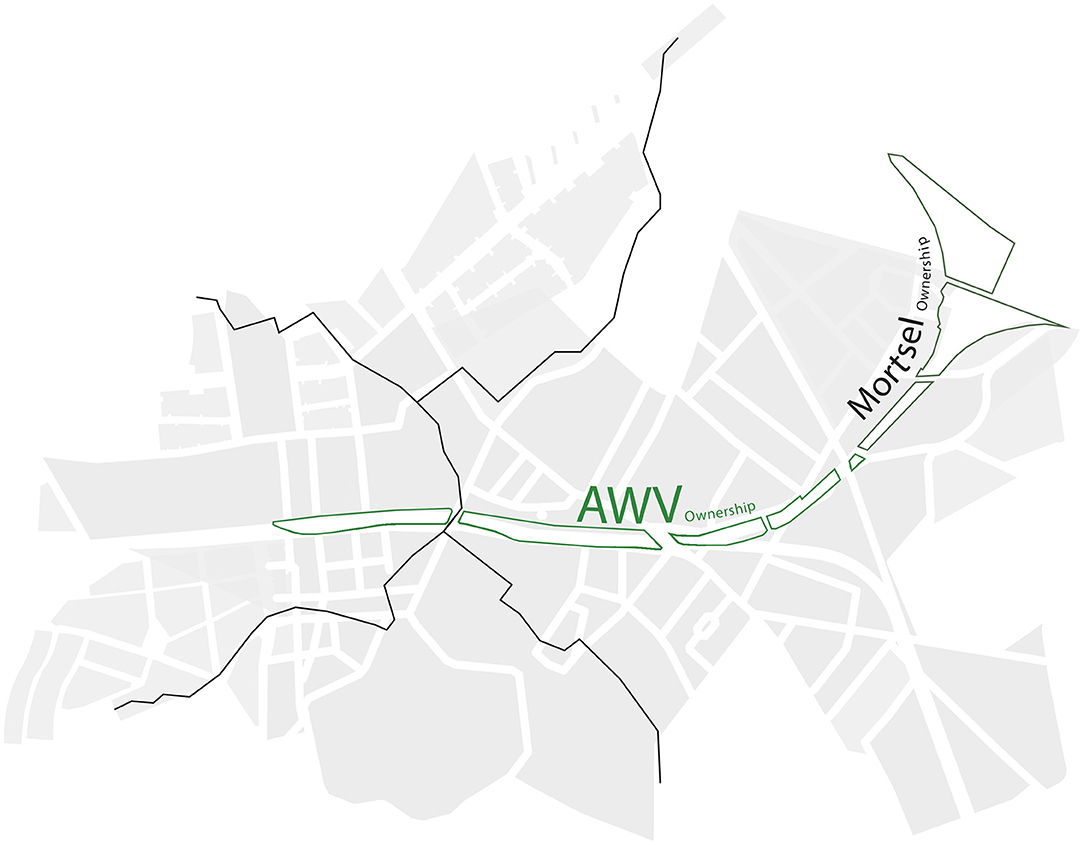
Figure 6. Land ownership of the Berm Source: Isan and Gebreyohannes Balcha (2019).
Natuurpunt (formed in 2002 as a merger between a national environmental organization called “Natuurreservaten”6 and “De Wielewaal” vzw7) is an independent volunteer association for the protection of vulnerable and threatened nature in Flanders.8 Natuurpunt sees the Berm as a naturalized area that needs more protection and involvement of the city of Mortsel. They, along with Gebermte and a growing number of members of the local community, are willing to accept stewardship of the area. On the other hand, the city of Mortsel and the district of Wilrijk poorly enforce the already existing management rules, which shows the lack of an inclusive collective agreement on the governance and use of the Berm. The Alderman of Mortsel nevertheless points out in an interview that “during the previous legislature, we set aside 300,000 euros to invest in this part of the embankment. A part that doesn't even belong to us”9 (08:45–59). Rooted in a cité, archande, the city would rather invest in other green areas than on land that is not completely theirs.
Although the non-profit association Trage Wegen vzw (TW) had on its agenda the preservation and valorisation of existing slow paths in Flanders, including the expansion and integration of local networks of slow paths into a wider area constellation (Trage Wegen vzw, 2015)—priorities that are rooted in a cité civique and cité ecologique logic—their participation in the 2019 edition of Gebermte followed a cité marchande logic. The fee for their participation in the said event was paid by KU Leuven, since their contract with the Province of Antwerp to assisting in preserving and expanding a network of slow paths across eight municipalities in the South of Antwerp, had already ended.10 Creating a network of slow paths (from which the Berm is one of the prioritized supra local connections) in order to reconnect the open space in the area, was one of the central projects of the Landschapspark Zuidrand (LZ) initiative that has been co-ordinated by the province of Antwerp since May 2012 (see Figure 7)11.
In the past, the Berm was prominent in the local political discourse and the local press. Local authorities and political actors and their CoPs put forward various ideas on the future of the Berm, such as the idea of transforming the Berm into a bicycle highway as a way of attracting subsidies from the Flemish government, enabling the construction of bridges to connect the various fragments of the Berm (an idea mainly rooted in a cité industrielle and cité marchande logic with a little cité ecologique flavor).12 But the political coalition of Mortsel and the Province of Antwerp did not pursue the idea due to the unsuitable trajectory and topography of the Berm for the establishment of a bicycle highway13 and the objections raised by some actors espousing a cité industrielle logic and others, such as the local political party Open VLD, which saw the Berm's potential to become a linear Park (adjacent to real estate development) rooted in a mixture of a cité écologique and cité marchande visions.14 Furthermore, the urbanists of the Mortsel planning office insisted on keeping the Berm as it was since their masterplans focussed on revitalizing other green areas15.
Eager to develop a critical understanding of slow paths as a LCs in the continuation of the KU Leuven research project INDIGO (Van den Broeck et al., forthcoming) and espousing a cité par projet and cité civique logic, researchers from KU Leuven joined the Gebermte initiative. This included a PhD researcher and her supervisors, three Master's thesis students and 20 international visiting PhD students.
From 2017, the emerging Host Community of the Gebermte initiative started to actively engage with the problematic of the Berm, claiming a more active use and protection of the space to safeguard and push back the imminent threat of land consumption through infrastructure development. The editions of this socio-cultural and artistic event in 2017, 2018 and 2019 marked the starting points for building a strong and sustainable strategy to reformulate the meaning of the bio cultural heritage for the Mortsel community. Rooted in a cité civique and écologique logic, but also in a cité marchande one, Gebermte supporters and volunteers—some of whom have backyards adjacent to the Berm—began trying to change the perception of the place in the imagination of the local inhabitants and other actors (CoPs, person-actors) using art as a tool to raise the interest of the people in the space.
Rooted in a cité par projet and cité civique vision, the 2019 Gebermte coordinators believe that “the art festival (with its next edition being planned for 2022) can contribute to the creation of a vision leading to cooperation among different actors whilst leaving space for dispute and different opinions to circulate.”16 Art and cultural productions are seen here as a different way to research, design and “develop” a place, seeing the lived environment as an influential actor. As part of the development of the place, a change in social practices (the perception, discourse and behavior of local actors) toward more engagement was sought after. The first edition of Gebermte in 2017 was intended to enable new natural and cultural experiences on the Berm by involving residents and visitors from Mortsel and Wilrijk. The second edition of the event in 2018 was supported by the CoPs R11 MIS,17 the nature conservation organization Natuurpunt, the city of Mortsel and the Antwerp district of Wilrijk.
The findings of the case study show how the local community consisting of different CoPs has become gradually involved in building the slow path on the Berm as a supra-local Commons with a gradually built-up hybrid governance arrangement. This arrangement brings together local and supralocal governmental institutions and local companies adjacent to the Berm willing to connect to the Berm, with some aiming to create a bridge to the adjacent road, 18 interactively build network relationships, as well as engage in spontaneous co-management relationships based on solidarity and affectivity.
Building the Slow Path: An Analysis of the Co-construction of a Landed Commons
The analysis in this section covers the period from October 2018 to December 2019, from the date the Gebermte coordinator and PhD researcher met until the creation of an agenda 2022 for the Berm and the first drafting of this paper.
The retrospective analysis reveals how the various actors became engaged in the making of the slow path on the Berm. In the following sections, the TdC+ and GPLC are used to reconstruct a chain of five interaction moments.
Interaction Moment 1: Origins of Gebermte 2019, Emergence of a Project Team
After the successful editions of the art-based initiative Gebermte in 2017 and 2018, the Gebermte group had no intention to organize a next edition in 2019. This changed when in October 2018, the leader of the “Gebermte” group met one of the authors of this paper, a KU Leuven PhD researcher seeking to extend her slow path case study in the Antwerp Southside by incorporating an eight-day Action research student workshop on the intermunicipal slow path connection on the Berm, that had been prioritized by LZ as a supralocal slow path connection.
From June to September 2018, together with her supervisor, the PhD researcher defined a potential case study, secured a first funding for the workshop from the Province of Antwerp, and developed first ideas on the trajectory of the case study Action research and the workshop. The participation and financial support of the Province reflected the shared interest between the PhD researcher, provincial civil servants and the provincial Deputy of Environment in becoming involved in Commoning processes, rooted in a shared cité civique (with a participatory mode of being inscribed in their operational-socio-institutional logic) and cité marchande (economic motivations). Within the context of Landschapspark Zuidrand (LPZR), a subregional project aiming to better organize and sustain open space and coordinated by the Province, a slow paths network had been targeted as a lever to create access to open land in this highly fragmented suburban area (cfr chapter 2.3 in Van den Broeck et al., forthcoming). Given the need to accelerate this process of re-Commoning, the Province was very interested in improving the public perception of this network through an out scaling process, in which the Action research student workshop and slow path interventions proposed by students could be instrumental. Furthermore, the emerging collaboration fit the Province's socio-institutional drive to find a response to it being downplayed in the socio-political system by the lead Flemish political parties and their public management inspired governance reforms of 2003, opening ways for the Province to claim its role as a main steward of cultural and natural resources and empower municipalities to capitalize upon the benefits that ecological and cultural ecosystems on their territory could offer.
The meeting between the leader of the Gebermte group and the KU Leuven PhD researcher radically changed the nature of the case study and the format of the workshop. The thesis students and the volunteers of Gebermte, along with the PhD researcher, her supervisor and the leader of the Gebermte group, launched the idea of organizing a “Gebermte 2019” edition in May 2019 under the title “Making a slow path”. Rooted in a cité civique logic that afforded a central role to Action research in spatial development analysis and planning, and sharing strong interest in artistic experiments19 rooted in a cité par projet vision, the idea was launched to organize a “Gebermte 2019” edition in May 2019 under the title “Making a slow path” (see also Figure 8 flier Gebermte 2019) This event would be developed as the PhD case study and would overlap with the Action research student workshop, which included: two colleagues of the Planning & Development Research Unit,20 students of a KU Leuven planning course and three KU Leuven Master's students (Colabianchi, 2019; Isan et al. 2019). As such, the event Gebermte 2019 was turned into an object of their consensus.
The process of Action research allowed participants to engage with local actors and to gain grounded insights into local dynamics of building a Commons. Camping 8 days on site and interacting with local individual and collective person-actors, the students were asked to (re)claim the slow path/Berm by doing interventions that used limited resources but pursued a maximum (societal) impact. The goal of the Action research was manifold: first, to support the civil society initiatives that had been appropriating the Berm in an emerging Commoning process (such as the CoP Natuurpunt's first attempts to make a nature management plan for the whole Berm), and to disseminate information to citizens of the CoP Berm Tigers21 as both had joined the more recent civil society initiative Gebermte; second, to imbue the Berm into multi-level governance initiatives dealing with the creation of a slow path network in the Antwerp Southside; third, to develop a critical understanding of Landed Commons in the continuation of the KU Leuven research project INDIGO (Van den Broeck et al., forthcoming).
Interaction Moment 2: Reaching Out to New (Institutional) Partners
Once the decision to organize a Gebermte 2019 edition was made, both the KU Leuven P&D research unit and the Gebermte group started their preparations for the event and reinforced their existing institutional and other partnerships. Originally reluctant to approve the case study and to join a partnership with the Gebermte group (following a cité industrielle logic) for efficiency reasons the Province prioritized keeping things simple as the Berm was already a strategic project in the Nature Smart Cities22 project of the Province's spin-off organization “Streekvereniging”. But both the Streekvereniging and the Province became partners in the project once they realized how ”the uptake of civil society initiatives like Gebermte could be useful for ensuring the continuation of the supra-local collaboration with the municipalities,”23 following cité par projet and cité civique logics.
Crucial for the Gebermte group (in terms of reinforcing their existing partnerships) was the interaction with the previous partners involved in Gebermte 2018 (i.e. the CoPs of the city of Mortsel, the district of Wilrijk, the Gebermte volunteers and organizers themselves, Natuurpunt and the Berm Tigers). These actors' willingness to participate once more was based upon a shared interest (rooted in a cité ecologique and civique) to further enable new natural and cultural experiences on the Berm. The city of Mortsel and district of Wilrijk's decision to renew their yearly formal approval and subsidy for Gebermte (informed by a cité civique logic) was, on the other hand, based on increasing the accessibility of the Berm and supporting its cultural activities. Furthermore, working toward an inter-municipal slow path increased the visibility of the Berm as a policy item, including the possibility of an eventual institutionalization of the event and the building of an advocacy platform to build a bottom-linked governance for the slow path.
As a consequence of the efforts by the KU Leuven P&D research unit and the Gebermte group to contact potential partners, more and more institutional partners24 gradually became involved in the process. The new forms of collaboration forged with new institutional partners provided increased financing and manpower for the Gebermte initiative. These partnerships also reinforced the groups' raison d'être and solidified their aim to bring about socio-political transformation and continue their work in the future. Each CoP's reason for involvement differed25.
Interaction Moment 3: Kick-Off Meeting, Bringing Together Important Stakeholders
At the beginning of April 2019, the KU Leuven P&D research unit and the Gebermte group organized a fieldtrip for students, some of the Action researchers and some of the protagonists of the other CoPs (Natuurpunt, city Mortsel, the Environment and Mobility department of the Province, the district of Wilrijk, the Berm tigers) that were going to participate in the preparations and implementation of Gebermte 2019. The joint framing of an academic exercise and a new narrative of Mortsel and the Berm as victims of historic and ongoing land consumption, favored participation of person-actors belonging to CoPs from sometimes divergent referential and socio institutional logics or conflictive interpersonal relations. Despite potential tensions, the fieldtrip actually became a kick-off event, making the Gebermte 2019 more tangible.
During this kick-off moment, most actors recognized the need for a supra-local management plan. While a nature conservationist (protagonist of Natuurpunt responding to its socio institutional logics) insisted on taking practical measures to protect nature and the reinforcement of the existing environmental rules, a preliminary management plan prepared by the Alderman of Mortsel responsible for spatial planning (and representing the socio institutional logics of his political party) focused mostly on improving the Berm's accessibility. In an interview the Alderman reaffirms his cité civique logic when he says: “When I first went into politics we upgraded the first part of the embankment that belongs to Mortsel, we laid paths there” (08:17). And later: “It is only in the past few years that the town of Mortsel has had the chance to take charge of looking after it and to use the embankment for Mortsel” (08:45).
This resulted in a conflict between the logic of Natuurpunt's cité ecologique and logic of the Alderman's cité civique. Since the nature conservationist had already made a management plan for the Berm upon Gebermte's request, his personal frustration (personal psychology) rose. He blamed the Alderman for the weak intentions of Mortsels' management plan in the area of nature conservation, for the City's lack of enforcement of existing rules and for the weak professional capacity in nature management compared to the district of Wilrijk.
One of the interventions during the Gebermte week addressed this tension, by displaying two completely different parts of the Berm as part of “a (non) botanical garden”, exposing the rich biodiversity interwoven with the varied past of the railroad. In addition, during one of the evening debates programmed during the Gebermte action week, ideas for supra-local entities playing a role in establishing a supra-local governance arrangement for the Berm were launched. For example, the project leader of LZ suggested that all the involved CoPs could have a role in the Berm's governance, with an eventual integration of the Berm in a regional landscape structure and working toward a Commons based supra-local governance structure.
Interaction Moment 4: Gebermte 2019 as an Object of Consensus: Working Toward a Manifesto
The decision to connect Gebermte 2019 to the Action research student workshop affected the way in which the Gebermte group, KU Leuven and various person-actors shaped Gebermte 2019. Gebermte 2019 would become a socio-cultural event, part of a research project with various student assignments (see Figure 9). The event that lasted 10 days included: work by sculptors, poets and a dance performers; real-live spatial interventions by students and Action researchers problematising issues related to the Berm; evening debates, opening and closing events; and a camping experience including tent sleeping, collective cooking and meals, camp fires, incidental meetings and parties. The interventions26 were embedded in a transdisciplinary Action research process involving multiple researchers and actors over an extended period of time and had an impact on how the realization of the supra-local slow path and the re-Commoning on the Berm could be experienced, perceived, discussed and put into practice and policy. To this end, the locations where the interventions were co-created had to be approached as:
Open and experimental scenographic settings where “live performances” about the making of slow paths were “put on stage”, and in which an exchange between the intervention and the scenery of the Berm would be assured27.
During the planning process and especially the Gebermte week, certain aspects became clearer, such as the Berm's rich biodiversity, its cultural heritage, its fragmentation and its unhealthy natural surroundings (as the Berm is a natural filter to provide clean air and absorb noise from heavy traffic and industry). Three of Gebermte's interventions were key in exposing the Berm's biocultural heritage: the (Not) Botanical Garden on (threats to) biodiversity (see Figure 10), Making a slow path (see Figure 11) suggesting a ground level eco-corridor, and the Urban Yoga on (un)health (see Figure 12), a flash mob yoga session on the Berm. The Gebermte 2019 event attracted new local community members and unexpected person-actors, such as the governor of the Province, aldermen, members of municipal councils, representatives from adjacent companies (see Figure 13), the Flemish Government Architect, a neighborhood group, activists and colleagues from KU Leuven's P&D department (see Figure 14), children from neighboring schools (see Figure 15) and other resident organizations dealing with bike highways. Moreover, following the interactions with protagonists from this edition of Gebermte, the city of Mortsel and Edegem and the district of Wilrijk showed interest in collaborating on the issue of the Berm. In sum, expressing the qualities of the Berm according to biodiversity and heritage values, the cultural activities during the event revealed hidden/neglected values and weaknesses, and triggered collaboration and outreach to additional actors.
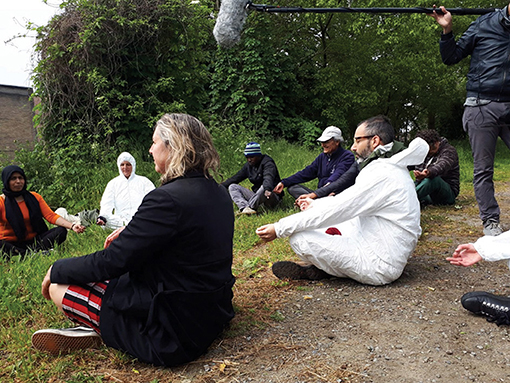
Figure 12. Urban yoga on (Un)health. Gebermte 2019. Photographer: Anastasia Widyaningsih, IMSDDP student –VLIR-OUS.
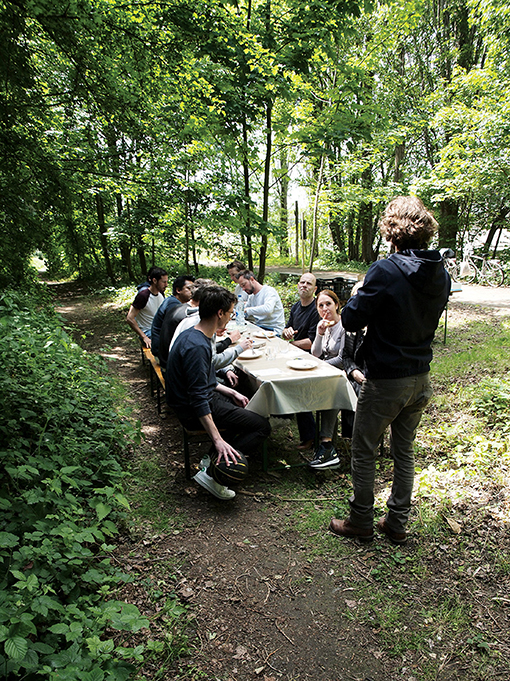
Figure 13. Lunch with local entrepreneurs from companies adjacent to the Berm. Photographer: Sebastiano Cutrupi IMSDP student.
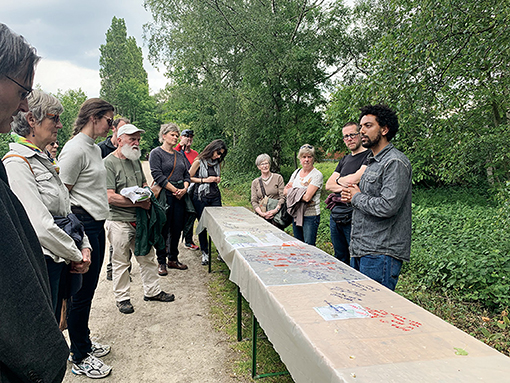
Figure 14. Participative Intervention on the meaning of the Berm. Photographer:Sofia Saavedra Bruno.

Figure 15. Intervention with children from adjacent school. Photographer Sebastiano Cutrupi, IMSDP student.
The Action research changed the character of the socio-cultural event. Apart from working toward concrete interventions, the very meaning of the Berm as a Landed Commons and the GPLC were discussed among the participants and more indirectly during the public evening debates (see Figure 16). These analyses facilitated tailoring of partnerships; as such, the Action research can be understood as a Commoning act in itself (cf. Moulaert and MacCallum, 2019). In this regard, some Gebermte volunteers experienced the event as too academic. Amongst those who left or chose to discontinue their involvement at this stage were some students and local activists (who evidently lost interest and momentum in the project). Furthermore, the public agency for infrastructure (Agentschap Wegen en Verkeer AWV) and one of the landowners of the Berm left the negotiations (despite having been repeatedly invited). AWV had outsourced the management of the Berm to the city and did not consider slow path making as its core business. Its director, rooted in a cité marchande and industrielle (efficiency) logic, declined from being interviewed. Nonetheless, the Action research was a significant step in the making of Gerbermte as a slow path: it revealed the needs of the participants more clearly, defrosted social relations between the person-actors and their CoPs and meant a first step toward the establishment of a supra local governance for the slow path and its socio-political formation.
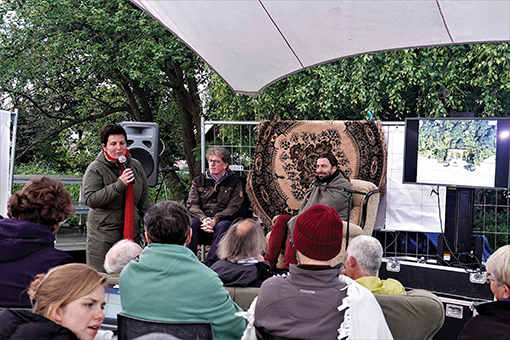
Figure 16. Gebermte debate on Eco Commoning with trage Wegen vzw and ex deputee Rik Röttger. Photographer Paul Van Dijck 151.
The compromise of a cité écologique and civique expressed the will to care for the environment and also improve the accessibility of the Berm for the local community. Gebermte volunteers managed to affirm their CoP amidst the local inhabitants of Mortsel, as well as gain more visibility among institutional partners and actively engage in the Action research. A Gebermte artist, for example, slightly modified his art installation from the previous year by adding an ecological element addressing the need for bridges and accessibility of the Berm for humans and nature. Students, Gebermte volunteers, artists and local activists suggested and implemented strong interventions and all participants launched a manifesto at the closing event.
Person-actors gathered around the Gebermte event and forged common visions regarding the Berm as they were driven by the need to address the constant threat of (car) infrastructure infringing upon the area, the need for a supra-local management plan as well as the need to re-connect the different fragments of the Berm and to relate the Berm to the local community as a Common space. Thus the Gebermte 2019 event itself can be considered as a context or even an object of consensus. Drawing on a historical analysis of the Berm, based on a thorough reading of its history and institutional context, interactions with person-actors and the experiences of the Action research workshop week, recommendations were put forward for the future of the Berm. In parallel, coordinators and action researchers brought on board the person-actors and their CoPs that were considered strategically important. The shared vision expressed in the manifesto argued for a continuation of the collective process of place-making initiated by Gebermte, for reinforcing existing social relations and connecting and reaching out to other (political)-institutional partners. The manifesto aimed to empower the community's claim on the Berm and foster its socio-political embeddedness, with a Commons-based supra local nature management plan and more artistic interventions, linking nature and culture, emphasizing its biocultural heritage. The following main strategies were recommended:
• Simultaneously strengthening the ecological and cultural value of the Berm with a supra local nature management plan and artistic interventions.
• Connecting the different parts of the Berm with each other and to the broader green structure. The connections here refer to an eco-corridor intervention whereby not only humans but also animals should be able to cross from one part of the Berm to the other and to the surrounding open land of LZ (an area that remains disconnected because of car traffic and railway tracks, see Figure 11).
• Consolidating the community's appropriation of the Berm while also enlarging the Berm's Host Community.
• Institutionalizing the Berm: “Protecting the Berm” by, for example, placing it on the 2020 World Monuments Watch list.
Interaction Moment 5: Toward an Agenda Gebermte 2022
After the Gebermte 2019 week, a policy brief was drafted summarizing the main findings of the manifesto and the Gebermte initiative process; these could be considered the emerging object of consensus of this interaction moment. Further post-processing activities contributing to the draft policy brief included the preparation of INSIST-328 summarizing the experience of students and action researchers, the Master's theses, the evaluation meeting, and the Gebermte 2019 documentary. The policy brief has been handed to the current provincial deputy and the person-actors representing potential (institutional) partners, including the representatives of the city of Mortsel, the district of Wilrijk and protagonists of the province and the other involved CoPs (such as Natuurpunt, R11 Mis, Gebermte, etc.). In the meantime, Gebermte took the initiative to draft an “Agenda 2022” for the Berm. The idea is to work toward various institutionalizing strategies for the conservation and sustainability of the Berm, to be further elaborated by all involved actors.
Retrospective Reflection of the Gebermte 2019 Co-construction Process, Structured Along Principal Dynamics and Assessed With The GPLC
The narrative built on the interaction moments brings to light how the TdC+ Action research in the event became an object of consensus and process of Commoning in itself. We identified four dynamics along the interaction moments of the process of negotiation and co-construction, including: (1) The gradual appropriation of the Berm by the Community, (2) The growth of the Host Community, (3) Building a supra local Commons, based on a hybrid governance arrangement, (4) The bringing together of nature, culture and community. In this section, these dynamics are mirrored onto the Grand Principles of the Landed Commons (GPLC). The narrative built on the interaction moments brings to light how the TdC+ Action research in the event became an object of consensus and process of Commoning in itself. We identified four dynamics along the interaction moments of the process of negotiation and co-construction, including: (1) The gradual appropriation of the Berm by the Community (2) The growth of the Host Community (3) Building a supra local Commons, based on a hybrid governance arrangement (4) The bringing together of nature, culture and community. In this section, these dynamics are mirrored onto the Grand Principles of the Landed Commons (GPLC) (see Figure 17).
• A first dynamic that unfolded and was reinvigorated by the Gebermte event was the appropriation of the Berm by the community. By gradually appropriating (the slow path on) the Berm and through the Action research, the Berm was propagated as an area that by its very nature and use must be regarded as naturally communal, implying shared land use. As such, community based use was propagated by the act(s) of Commoning. In this way this dynamic responds to GPLC1.
• A seed of a growing Host Community (GPLC 9) was planted—a community which is also expected to play a significant role in the establishment of a supra local governance plan for the Berm. Throughout the preparations and implementation of Gebermte 2019, a large number of person-actors became gradually involved. Meeting, discussing, negotiating, collaborating, disagreeing, cooking, building, sleeping, singing, presenting, painting, teaching, inquiring, etc. All these activities embodied the Commoning process and the emergence of the Berm as a Commons, thus creating a community expressing care for the Berm. The Host Community gradually grew to encompass the CoPs of Gebermte, Natuurpunt, R11 Mis, the city of Mortsel, the district Wilrijk, the action researchers, the Province, a regional association and local companies and later on the office of the Flemish Government Architect.
Building a Supra-Local Commons, Based on a Hybrid Governance Arrangement (GPLC 5)
The Gebermte 2019 event enabled the making of the first steps toward the establishment of a supra-local governance arrangement for the Berm. Potential institutional partners (GPLC 8) were reached and, making good use of the institutional diversity (GPLC 3), mixed legal arrangements were considered (e.g., the situation of the usufruct but also the nature management of different parts of the Berm outsourced by AWV and the city of Mortsel). Furthermore, a diversity of institutional configurations structuring CoPs were established (e.g., the perspective of a tilting in the existing regional association Regionaal Landschap Rivierenland into the institutional constellation). The latter was based on a collectively agreed upon or a mediated system of diverse land use rights, supporting a diversity of shared land uses (GPLC1). Immediately after the Gebermte 2019 event, the idea of a supra-local governance was somehow included in the political agreement of the new coalition of the district of Wilrijk. A resolution was included that stipulates Wilrijk's intention to examine with Mortsel how (green) connections can be made between the two parts of the Berm.
Bringing Together Nature, Culture and Community
Throughout the building of the Gebermte initiative, a socio-ecological relationship between involved actors (in its expanding Host Community) and the land of the Berm gradually took shape (GPLC6). This turned person-actors into caring stewards mediating use claims to the Berm (GPLC 9) while deliberating which parts of the Berm should be non-accessible (GPLC 10). The intervention to install 300 signposts preforming/prefigurating the (non) botanical garden, can be considered as a simulation of how socio-ecological relations can evolve in the future.
Putting the relationship between nature and art/culture at the heart of the Gebermte event proved to be instrumental in creating links with the local community. Artistic interventions and debates were integrated into the event (interaction moment 4), which also questioned nature-culture relations. Participation in and contributions to the event came not only from externals (students, action researchers and artists), but also from local volunteers and inhabitants of the local communities. The artistic interventions facilitated this process of person-actors including the (action) researchers revealing themselves within the process of imagining and building a Commons; this allowed for the construction of alternative imaginaries and ideas to solve key issues and open the space for new values and symbolisms.
Art (and nature) festivals can contribute to the creation of a vision allowing room for conflict, yet leading to cooperation among different person-actors (Segers, 2019). Art and cultural productions are seen as an alternative way to research, design and “develop” a place, looking at the lived environment as an influential actor. As part of the development of the place, a change in social practices (the perception, discourse and behavior of local actors) toward more engagement is pursued29. Gebermte's (unsolicited) performative interventions nevertheless go beyond being only an alternative approach for engaging people and communities in the planning process and in addressing some of the limitations of more formal opportunities for citizen consultation and engagement. Instead of focusing on artistic or designerly hit and run tactics, the starting point in Gebermte 2019 was the focus on interventions embedded in processes involving multiple actors over an extended period of time. Performed in this way, small-scale actions can affect larger systems (Supersudaca, 2007; Hamers et al., 2017) and eventually provoke social change (Moulaert and Van Dyck, 2013).
By simultaneously mobilizing the cité civique and écologique of the local actors and stakeholders, the Gebermte initiative has been instrumental in transcending social, ecological and economic interests to work toward a compromise to make the Berm more accessible i.e., consolidating the slow path on the one hand, while restricting areas for nature conservation on the other. As such, the case study illustrates how slow paths as intermediary spaces can provide leverage for a Commons-based governance of diverse land use. In other words, it shows how Commons can bring back the community logic in the governance of diverse land use.
Conclusion
This paper applies the TdC+ cum GPLC to explore the transformative potential of the Action research and Commoning that took place in the context of the arts-based local initiative Gebermte 2019 on the negotiation and co-construction of an intermunicipal slow path and its governance. The paper demonstrates how the theory can help understand processes of Commoning by combining an analysis of the shifts in positions of person–actors with an assessment of the co-construction dynamics based on the GPLC. It analyses how the shifts in person-actors' positions are influenced by their socio-institutional logics, their place in the socio-political system, their cité affinities and the dynamics of (inter)actor justification and negotiation processes in which personal, interpersonal and social psychologies play a role. Furthermore, the paper brings to light a real-case scenario to apply theoretical lessons from the TdC+.
By operationalising TdC+ for Action research, a multi-layered learning process was introduced into the Commoning process around the Berm, and especially the Gebermte 2019 edition, in which the findings from the retrospective analysis became inputs for the partnership architecture. Bringing in students and building connections between various groups allowed for a more explicit problematisation of the issues regarding the Berm. The cités were used to identify the actors' political and philosophical affinities; the GPLC were used to reflect on the progress in the Commoning process, but also to guide actors in identifying what they considered as essential features of a CLC. As part of the process, a documentary was introduced as an alternative way of assessing referential logics and personal and interpersonal psychology. The artistic interventions, debates, and eventually also the documentary, triggered these actors to change their argumentations and commitments to team up and collaborate.
The paper illustrates how Action research becomes a Commoning process that strives to reveal the more normative dynamics of collaboration, solidarity, and human respect in the research governance model. In TdC+ led Action research, the research team becomes a Commons, a group that governs itself according to the principles of bottom-linked governance. This means that,
There is room for reflection, consultation, personal solidarity, networking with other person-actors and CoPs, but also for questioning university hierarchies, the breaking of traditional validation approaches and the questioning and lobbying for changes in the research policies of universities as well as government agencies (oral source: Moulaert, 2018).
In line with this, the paper explains how during the Gebermte 2019 edition, the Action research team became (part of) the Commons itself. The case study shows how Commons emerge, express, instantiate and manifest themselves in the act of Commoning and how Commoning is itself a Commons. This goes beyond an understanding of Commoning as the (purposeful) making of the institutions governing a Commons often found in the literature. “Making a slow path”, which has been at the heart of the Gebermte activities from mid-2018 onwards, expresses the same idea. As Nieto-Romero et al. (2019) point out:
Analyzing and promoting the formation of communities imply going beyond exploring practices of decision making; to do so includes exploring all practices of socialization and interaction among humans and non-humans, like collective working, consumption of goods, festivities, etc. which can support changes in subjectivities (Linebaugh, 2009; Fournier, 2013; Bollier and Helfrich, 2014; Nieto-Romero et al., 2019).
This paper illustrates how Commoning can contribute to the creation of a vision, allowing possible conflict to take place, but leading to cooperation among different actors and resulting in a more democratic form of planning that embraces feelings, values and reasonings of various actors. Ethically, both Commons and Action research can be situated in the desire, or need, of people and groups to make social progress. The starting point is that “Action research should be just as much a Common as the ‘Commons under construction' itself” (Moulaert, 2018: oral source). The use of an Action research theory as TdC+ means a considerable value is added to the social efficiency of the Action research process.
Data Availability Statement
The original contributions presented in the study are included in the article/supplementary material, further inquiries can be directed to the corresponding author/s.
Ethics Statement
Written informed consent was obtained from the individual(s) or minor(s)' legal guardian/next of kin for the publication of any potentially identifiable images or data included in this article.
Author Contributions
SSB wrote the paper in context of her PhD. LI and WB participated in context of their master thesis research. PV was the promotor of SS-B. All authors contributed to the article and approved the submitted version.
Conflict of Interest
The authors declare that the research was conducted in the absence of any commercial or financial relationships that could be construed as a potential conflict of interest.
Publisher's Note
All claims expressed in this article are solely those of the authors and do not necessarily represent those of their affiliated organizations, or those of the publisher, the editors and the reviewers. Any product that may be evaluated in this article, or claim that may be made by its manufacturer, is not guaranteed or endorsed by the publisher.
Footnotes
1. ^Part of the proposal of the mobility masterplan was the second ring road R2, partially using the Berm for its trajectory. The project for R11 Bis and A102 of the mobility masterplan along with the “Oosterweel connection” in the North of Antwerp suggests a cut and cover tunnel under the Berm, implying the demolition and reconstruction of the Berm. This proposal triggered protests from the local activist group'De Bermtijgers' (The Berm Tigers), which took up the challenge of finding and disseminating information to the local community about the supra-local decision-making. Moreover, the Bermtijgers founded the platform “R11 Mis” and an NGO to be legally equipped against the R11 Bis. R11 Mis along with Natuurpunt and other civil society organizations, organized the “Red de Berm” (save the Berm) protest in 2011 against the Flemish government's plans for the R11 Bis. Source:Interview Bermtijgers March 4 th 2019.
2. ^Following a negative study on air quality along car infrastructure, local activists organised a bigger protest in 2014. It was the first time the Ringland flag was raised on the Berm, outside of Antwerp, marking the joined forces of Bermtijgers, Natuurpunt and Ringland activists. Source: Interview Bermtijgers March 4 th 2019.
3. ^https://www.landvanreyen.be/R11 Bis/R11 Bis-problematiek.
4. ^Interview Bart Van Camp (Lantis) 19 December 2020.
5. ^Mail correspondance and telephone call with Eva Van den Bossche (AWV), 21 May 2019.
6. ^Interview Griet Lambert, March 2019.
7. ^Non-profit Flemish ornithological and bird protection association. “De geschiedenis van Natuurpunt,” Natuurpunt, accessed April 16, 2019, https://www.natuurpunt.be/pagina/de-geschiedenis-van-natuurpunt
8. ^“Over Natuurpunt,” Natuurpunt, accessed April 30, 2019, https://www.natuurpunt.be/pagina/over-natuurpunt
9. ^Interview in documentary with Alderman Steve d'Hulster Mortsel, 30 April 2019.
10. ^Several meetings and interviews with Trage Wegen vzw prior to the event on 11 December 2018, 25 and 27 February 2019, and in documentary 30 April 2019.
11. ^Several meetings and interviews with Lotte Meuleman and Sabine Caremans, Province Antwerp (18 June 2018, 25 October 2018, 28 February 2019, 18 June 2019, 5 October 2019) and interview in documentary 30 April 2019.
12. ^Interview in documentary Erik Broekx Mayor Mortsel April 30th 2019.
13. ^Interview Sara Van Elsaker- Mobility Province Antwerp-Febraury 28th 2019.
14. ^“Open Vld Wil Park Spoor Zuid (Wilrijk) - Gazet van Antwerpen.” Accessed April 30, 2019. https://www.gva.be/cnt/dmf20180824_03681539/open-vld-wil-park-spoor-zuid
15. ^Interview urbanists city of Mortsel Joachim Walgraves en Bart Boonen March 28th 2019.
16. ^Presentation Basic ingredients Gebermte by Bart Pluym. April 25th 2019.
17. ^The Bermtijgers founded the platform ‘R11 Mis' and an NGO to be legally equipped against the R11 Bis. See also their website: https://www.landvanreyen.be/R11 Bis/R11 Bis-problematiek.
18. ^Interview with Opnieuw and Co-manager in Mortsel/Edegem- view on realization crossing the road called “Militaire Baan”. 3 June 2019.
19. ^Particularly useful was the PhD researcher's familiarity with designerly interventions and urban actions in public spaces, drawing from her experience as a founding member of the architects collective Supersudaca and in previous Gebermte editions and research activities.
20. ^Research unit Planning & Development, Department of Architecture, KU Leuven.
21. ^The Bermtigers Bermtijgers are a CoP that took up the role of informing the local community about the government R11 Bis plans (through the creation of the R11 Mis platform).
22. ^A European territorial cooperation programme with the overall objective to develop an innovative, knowledge and research based, sustainable and inclusive 2 Seas area, where natural resources are protected and the green economy is promoted.
23. ^Interview Sabine Caremans 5 October 2019.
24. ^This included the Environment and Mobility department (Dienst Duurzaam Milieu en Natuurbeleid and Dienst Mobiliteit) of the Province of Antwerp, the intermunicipal organization “Streekvereniging Zuidrand”, the governor of the Province of Antwerp, the Flemish Government Architect (Vlaamse Bouwmeester), the non-profit organization for the protection of slow paths “vzw Trage Wegen”, the municipality of Edegem, KU Leuven students and action researchers, guest tutors from the architects collective Supersudaca and the University of Newcastle, a local school, a youth organization and a cultural centre.
25. ^For example, Trage Wegen vzw's participation hung upon a cité marchande perspective as the KU Leuven P&D funded their participation; the municipality of Edegem presumably participated to gain political visibility as the opening and closing event were programmed one week and one day before the municipal elections.
26. ^An Intervention is an approach in which (unsolicited) short-term actions are understood as part of long-term participatory processes. Instead of focusing on artists or designers hit and run tactics, interventions are considered as embedded in processes involving multiple actors over an extended period of time. Performed in this way, small scale actions can affect larger systems (Hamers et al., 2017; Supersudaca, 2007) and eventually provoke social change (Moulaert et al., 2013). An (unsolicited) performative intervention can be an alternative method for engaging stakeholders and communities in the planning process (that addresses some of the limitations of more formal opportunities for citizen consultation and engagement).
27. ^Presentation Basic ingredients Gebermte by Bart Pluym. 25 April 2019.
28. ^See the website publication: https://www.insist.earth/cahier-3/prologue/celebrating-slow-paths.
29. ^Bart Pluym, Quote presentation Gebermte IASP Course 25 April 2019.
References
Albrechts, L. (2001). “From traditional land use planning to strategic spatial planning. The case of Flanders”, in L.Albrechts, J. Alden and A. Da Rosa Pires (Eds.), The Changing Institutional Landscape of Planning (pp. 83–103). Ashgate Publishing Company.
Bollier, D., and Helfrich, S. (2014). The Wealth of the Commons: A World Beyond Market and State. Levellers Press.
Boltanski, L., and Thévenot, L. (1991). De La Justification. Les économies de La Grandeur. Gallimard.
Braem, R., and Strauven, F. (2010). Het lelijkste land ter wereld. Heruitgave naar aanleiding van de 100ste verjaardag van Renaat Braem's geboortejaar. ASP Editions.
Colabianchi, M. (2019). Natural(ly) common Exploring possibilities for nature re-commoning in the Southside of Antwerp. Thesis to obtain title of Master's of Urbanism and Strategic Planning. KU Leuven.
Dardot, P., and Laval, C. h. (2014). Commun, Essai sur la révolution au XXIe siècle. Editions La Découverte. doi: 10.3917/dec.dardo.2015.01
De Angelis, M. (2017). Omnia Sunt Communia: On the Commons and the Transformation to Postcapitalism. Zed Books. doi: 10.5040/9781350221611
De Decker, P. (2004). De ondraaglijke lichtheid van het beleid voor de stad in Vlaanderen. Van gndividualiseerd woonmodel tot stedelijke crisis, een sociologische analyse, Unpublished thesis, Universiteit Antwerpen.
De Decker, P. (2011). Understanding housing sprawl: the case of Flanders, Belgium. Environ Plann. A 43, 1634–1654. doi: 10.1068/a43242
De Moor, T. (2012). What do we have in common? A comparative framework for old and new literature on the commons. Int. Rev. Soc. Histo. 57, 269–290. doi: 10.1017/S002085901200020X
De Rynck, F., Pauly, R., and Verschuere, B. (2017). Nieuw Publiek Management in Vlaanderen en de Impact op het Middenveld. CSI Flanders.
Dellenbaugh, M., Kip, M., Bieniok, M., Müller, A., and Schwegmann, M. (2015). Urban Commons: Moving Beyond State and Market. (Vol. 154). Birkhäuser.
Erfan, A. (2013). An experiment in therapeutic planning: Learning with the Gwa'sala-'Nakwaxda'xw First Nations (Doctoral dissertation). University of British Columbia, Vancouver, BC, Canada.
Euler, J. (2018). Conceptualizing the Commons: Moving beyond the goods-based definition by introducing the social practices of Commoning as vital determinant. Ecol. Econ. 143, 10–16. doi: 10.1016/j.ecolecon.2017.06.020
Fournier, V. (2013). Commoning: on the social organization of the commons. Management. 16, 433–453. doi: 10.3917/mana.164.0433
Ganugi, G. (2018). The role of commoning and mutually shaped citizenship in developing bottom-linked governance. Sociol. Polit. Soc. 21, 51–70. doi: 10.3280/SP2018-002003
Hamers, D., de Mesquita, N. B., Vaneycken, A., and Schoffelen, J. (2017). Trading Places: Practices of Public Participation in Art and Design Research. dpr-barcelona.
Hardin, G. (1968). The tragedy of the Commons. Science. 162, 1243–1248. doi: 10.1126/science.162.3859.1243
Harvey, D. (2013). Ciudades rebeldes: del derecho de la ciudad a la revolución urbana. Ediciones akal.
Helfrich, S. (2012). “Common goods don't simply exist–They are created”, In The wealth of the Commons. A World Beyond Market and State. p. 230–249. doi: 10.14361/transcript.9783839420362
Iaione, C. (2012). City as Commons. Available online at: www.collectiveaction.info/conference/sites/default/files/Iaione_prelversion.pdfKip (accessed October 4, 2013) doi: 10.2139/ssrn.2589640
Isan, L., and Gebreyohannes Balcha, W. (2019). “Interactionmoments in the history of “De Berm” and themes for discussion”, in Made at the occasion of Gebermte 2019 for Institutional Aspects of Spatial Planning (IASP) and International Commons Workshop (ICW) - Annex to the IASC and ICW brief and an insert in thesis to obtain title of Master of Urbanism and Strategic Planning. KU Leuven.
Kesteloot, C. (1990). De economische determinanten van de stedelijke structuren. Ruimtelijke Plann. 25, 1–42.
Kesteloot, C. (1993). “Suburbanisatie en stadsgewestvorming”, in E. Taverne and I. Visser (eds.) Stedebouw.Geschiedenis van de stad in de Nederlanden van 1500 tot heden (p. 256–260). SUN.
Kip, M. (2015). “Moving beyond the city: Conceptualizing urban Commons from a critical urban studies perspective”, in M. Dellenbaugh, M. Kip M. Bieniok, A. K. Muller, and M. Schwegmann (eds.), Urban Commons. Moving beyond State and Market (pp. 42–59). Birkhauser Verlag GmbH. doi: 10.1515/9783038214953-003
Linebaugh, P. (2009): The Magna Carta Manifesto: Liberties and Commons for All. University of California Press. doi: 10.1525/9780520932708
Manganelli, A., and Moulaert, F. (2018). Hybrid governance tensions fuelling self-reflexivity in Alternative Food Networks: the case of the Brussels GASAP (solidarity purchasing groups for peasant agriculture). Local Environ. 23, 830–845. doi: 10.1080/13549839.2018.1477745
Manganelli, A., Van den Broeck, P., and Moulaert, F. (2020). Socio-political dynamics of alternative food networks: a hybrid governance approach. Terr. Polit. Govern. 8, 299–318. doi: 10.1080/21622671.2019.1581081
Mattei, U. (2013). Protecting the commons: water, culture, and nature: the commons movement in the Italian struggle against neoliberal governance. South Atlant. Quart. 112, 366–376 doi: 10.1215/00382876-2020244
Meretz, S. (2014). Socialist licenses? A rejoinder to michel bauwens and vasilis kostakis. triplec: communication, capitalism and critique. Open Access J. Global Sustain. Inf. Soc. 12, 362–365. doi: 10.31269/triplec.v12i1.564
Mindell, A. (1995). Sitting in the Fire: Large Group Transformation Using Conflict and Diversity. Deep Democracy Exchange.
Morozov, E. (2013). To Save Everything, click here: the Folly of Technological Solutionism. Public Affairs.
Morozov, E., and Bria, F. (2018). Rethinking the Smart City. Democratizing Urban Technology. Rosa Luxemburg Foundation.
Moulaert, F. (2018). “Commoning as Action Research-Action research as Commoning”, in Oral Source presented at the occasion of the Launch of the Book Kuhk, A., Holemans, D. and Van den Broeck, P. (2018). Op grond van samenwerking: woningen, voedsel en trage wegen als heruitgevonden Commons. Epo.
Moulaert, F., MacCallum, D., Mehmood, A., and Hamdouch, A. (2013). “The International Handbook on Social Innovation, Collective Action, Social Learning and Transdisciplinary Research”. Edward Elgar Publishing. doi: 10.4337/9781849809993
Moulaert, F., and MacCallum, D. (2019). Advanced Introduction to Social Innovation. Edward Elgar Publishing.
Moulaert, F., MacCallum, D., Mehmood, A., and Hamdouch, A. (2013). The International Handbook on Social Innovation: Collective Action, Social Learning and Transdisciplinary Research. Edward Elgar Publishing.
Moulaert, F., and Van Dyck, B. (2013). “Framing Social Innovation Research: A Sociology of Knowledge Perspective”, in F. Moulaert, D. MacCallum, A. Mehmood and A. Hamdouch (eds.). The International Handbook on Social Innovation: Collective Action, Social Learning and Transdisciplinary Research. Edward Elgar Publishing.
Nieto-Romero, M., Valente, S., Figueiredo, E., and Parra, C. (2019). Historical Commons as sites of transformation. A critical research agenda to study human and more-than-human communities. Geoforum. 107, 113–123. doi: 10.1016/j.geoforum.2019.10.004
Ostrom, E. (1990). Governing the Commons. The Evolution of Institutions for Collective Action. Cambridge University Press. doi: 10.1017/CBO9780511807763
Pauwels, F. (2014). Land Development in Flanders in a Changing Perspective. Zeitschrift Fur Geodasie, Geoinfor. Landmanage. 3, 159–166.
Polanyi, K. (2001). The Great Transformation: The Political and Economic Origins of Our Times. Boston: Beacon press.
Segers, R. (2019). “Action research with an artistic turn: the “Welcome (w)all muro “ project for youth in Bairro Da Cruz Vermelha, Lisbon”, in Social Innovation as Political Transformation. Edward Elgar Publishing. doi: 10.4337/9781788974288.00027
Supersudaca. (2007). “The antiurinator”, in Bernd Upmeyer and Thomas Soehl, Editors. Beautiful urbanism, Monu n. 6.
Swyngedouw, E., and Jessop, B. (2006). Regulation, Reproduction, and Governance: Achilles' Heel of Development, Thematic Synthesis paper 3, Demologos.
Trage Wegen vzw (2015). Veel Meer Dan Een Weg - Toekomstvisie Trage Wegen Vzw [More than a Road - Long-Term Vision Trage Wegen Vzw].
Van den Broeck, P., Leubolt, B., Kuhk, A., Moulaert, F., Parra, C., Delladetsimas, P., and Hubeau, B., (eds.) (forthcoming). Governing shared land use rights: conceptualising the Landed Commons. Edward Elgar publishing.
Van den Broeck, P., Moulaert, F., Kuhk, A., and Lievois, E. (2014). “Serving a bypassed capitalism?” in Spatial Planning Systems and Practices in Europe: A Comparative Perspective on Continuity and Changes. Vol. 169.
Van den Broeck, P., and Verachtert, K. (2015). Whose permits? The tenacity of permissive development control in flanders. Eur. Plann. Stud. 24, 387–406. doi: 10.1080/09654313.2015.1045838
Keywords: (performative)action research, Landed Commons, hybrid governance, urban nature, theorie des cites, social psychology, slow paths, access to open land
Citation: Saavedra Bruno S, Isan L, Balcha WG and Van den Broeck P (2022) “Making Slow Path”. The Arts-Based Event “Gebermte” as an Act of Commoning. Front. Sustain. Cities 4:743570. doi: 10.3389/frsc.2022.743570
Received: 18 July 2021; Accepted: 28 March 2022;
Published: 18 May 2022.
Edited by:
Dorota Dominika Kamrowska-Zaluska, Gdansk University of Technology, PolandReviewed by:
Joseph Edward Alegado, Ateneo de Manila University, PhilippinesSacit Hadi Akdede, Izmir Bakircay University, Turkey
Copyright © 2022 Saavedra Bruno, Isan, Balcha and Van den Broeck. This is an open-access article distributed under the terms of the Creative Commons Attribution License (CC BY). The use, distribution or reproduction in other forums is permitted, provided the original author(s) and the copyright owner(s) are credited and that the original publication in this journal is cited, in accordance with accepted academic practice. No use, distribution or reproduction is permitted which does not comply with these terms.
*Correspondence: Sofia Saavedra Bruno, c29maWEuc2FhdmVkcmFicnVub0BrdWxldXZlbi5iZQ==
 Sofia Saavedra Bruno1*
Sofia Saavedra Bruno1* Lavinia Isan
Lavinia Isan Wossen Gebreyohannes Balcha
Wossen Gebreyohannes Balcha